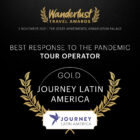2001: A Chilean Odyssey

The Guardian's Patrick Collinson walks on the wild side in Chile's Atacama Desert
Nine thousand feet up in the Andes, it bills itself as one of the highest, driest and remotest locations on earth. Its other-worldliness even invited the Spanish conquerors to name its barren volcanic plains and valleys aftermuerte (death), el diablo (the Devil) and la luna (the moon).
On arrival in Santiago, I went north, lured not just by the Atacama’s lunar attractions but by the sumptuous explora hotel, set in 42 acres on the edge of San Pedro village, an oasis wedged between the biggest salt flat in South America and the Andean mountaintops. San Pedro sits on the Salar de Atacama, a saline lake that has almost completely evaporated, and is the base for those looking to sample the Valle de la Luna, the geysers at El Tatio, the Puritama springs, Laguna Chaxa, or to climb the majestic Mount Lascansars, a perfectly formed volcano that exerts a Mount Fuji-style dominance over the region.
All of the Atacama’s attractions are considerably more than walking distance from the village, thus making transport a necessity. The available options range from taking an organised excursion, using 4WD vehicles, to hiring a mountain bike or even a horse to explore the region on your own.
At the explora hotel, I opted for a mountain-bike trip through El Valle del Diablo (Devil’s Valley). I jumped on my well-maintained Trek bike, and hurtled off across dried-up riverbeds and through freezing streams running down from the Andes. After a while I began to climb, through eerie rock formations and weird dusty landscapes. At this altitude, over 3000 metres above sea level, breathlessness soon sets in and the sun is deceptively strong. My prize for all this hard work was to be the ride down, skidding and sliding through tunnel-like gorges all the way home - exhilarating.
Hiring a horse for the day gives travellers that South American gaucho feeling, and was surprisingly not too frightening, even for someone like myself, who had never previously got further than the donkeys on Margate beach. The horses display a placidity that seems emblematic of the region.
For the less adventurous, there is the Valle de la Luna (Moon Valley), best done on foot. For me, this was the closest I came to experiencing just how totally lifeless and barren the Atacama is. It cuts through the salt, gypsum and clay, carving impressive but fragile shapes in the "Salt Range". Rain would erode and destroy La Luna, it’s just that it’s never forecast by the weathermen: it hasn’t rained here for over 400 years.
The eerie atmosphere of the Atacama is not just from the landscape; after a while you realise what is missing - there are no sounds, no birds flapping past, no wind blowing through the trees and leaves, nothing. Not even flies. Oddly, life in this part of the Andes begins rather than ends at 10,000 feet, as aridity is replaced by flowing melt-water. Giant cacti abound, vizcacha scurry between rocks, and wild donkeys stand motionless on the craggy hillsides, as you wander past deserted ancient Indian huts.
Some compare it to Arizona or Death Valley; I, a fan of trashy sci-fi, saw only the Hollywood moonscapes of Starship Troopers and Mission to Mars. I was not alone in feeling a bit spacey in the Atacama; NASA road tested its moon vehicles in the Valle de la Luna.
Atacama can leave you dusty and tired after every trip, but it’s a small price to pay for a region that is both one of the most peaceful and one of the most breathtaking in the world.



























